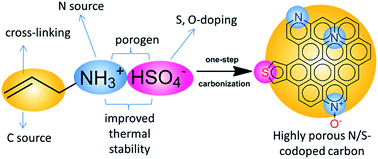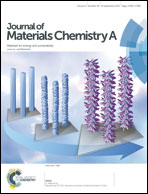One-step, template-free synthesis of highly porous nitrogen/sulfur-codoped carbons from a single protic salt and their application to CO2 capture†
Abstract
Traditional methods for preparing highly porous, nitrogen/sulfur-codoped carbons require either template-based tedious, time-consuming procedures or harsh chemical/physical activation processes. In this paper, we report a very facile method to prepare such carbons via the direct carbonization of a single protic salt, prop-2-en-1-aminium hydrogensulfate, in the absence of any hard/soft template or activation agent. Depending on the carbonization temperatures, the obtained carbons exhibited tunable structures and properties, in terms of their morphologies, surface areas, pore structures, and chemical compositions. Particularly, the carbon material obtained at 1000 °C had a very large surface area (1149 m2 g−1), even comparable to that of traditionally activated carbon. Among all the samples, the carbon obtained at 900 °C, exclusively having a narrowly distributed microporous structure, exhibited a significant CO2 uptake of 2.58 mmol g−1 at 298 K and 1 atm. This carbon could also be easily regenerated and reused without any evident loss of CO2-adsorption capacity.


 Please wait while we load your content...
Please wait while we load your content...